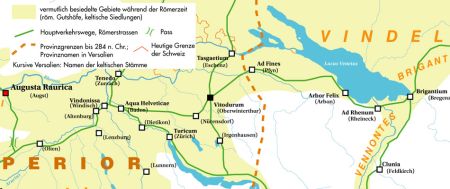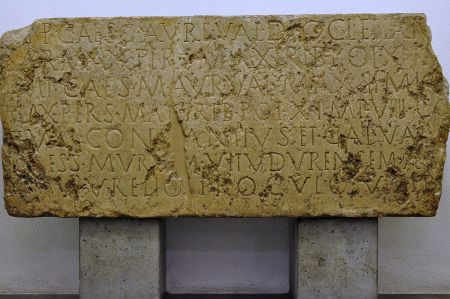Once Roman settlement Vitudurum - today Winterthur
- Written by Portal Editor
When it was founded, Vitudurum was in the province of Gallia Belgica and during the Roman Empire it was in its successor province, Germania Superior, which existed from the year 90 to the end of the 3rd century. In late antiquity, the Vicus Vitudurum was in the province of Maxima Sequanorum, created by the administrative reform of the Roman Emperor Diocletian (284-305) around 297 AD.
In terms of transport, the Vicus was on the Roman road coming from Vindonissa (today Windisch) and Aquae Helveticae (today Baden) to Ad Fines (today Pfyn), Arbor Felix (today Arbon), Ad Rhenum (Warsch. St. Margrethen) and Brigantium (today Bregenz ). Further connections lead from Vitudurum southwards via the Irgenhausen fort to Kempraten and northwards towards Tasgetium (Eschenz).
The Vicus Vitodurum itself was built at the south-east foot of the Lindberg. Excavations show that the organic material of the vicus was well preserved due to the partially soaked terrace. The center of the vicus was on the so-called church hill, a spur formed by the Eulach and the Riedbach.
Vicus Vitodurum - a typical settlement of Roman times
A vicus (plural: vici) was a small-town settlement in the northern provinces of the Roman Empire. The economic focus of such settlements was in commercial production, handicrafts, trade and services. The designation was independent of the size of the settlement; depending on their function, they ranged in size from a small street settlement to the sprawl of contemporary cities.
Linguistically, the term vicus can be traced back to the Indo-European expression weik, which in its basic meaning probably stands for house. If you look up vicus in the dictionary, the translations court, (country) spot, district or alley are often given. So the word must have been a designation for districts of Rome and with the expansion of Roman territory it became the designation of an out-of-town district, i.e. a small satellite town. It is often referred to as vicus, which is neither clearly municipium nor colonia nor villa rustica. This very open definition is supplemented by assignment according to certain characteristics such as the building plan structure, public buildings or function.
Roman vici had no administration of their own, no legal status and were assigned to the regional authority of a civitas. However, some vici themselves achieved the status of a civitas capital (e.g. Nida-Heddernheim or Pforzheim). Not all had public buildings such as thermal baths or temples. Some locations of the vici could be located using the tabula peutingeriana and the itinerarium antonini.
Isidore of Seville described vici as settlements "that are not distinguished by the rank of a municipality, but are inhabited by an ordinary community of people and, because of their tiny size, are assigned to larger communities."
A Roman fort is built for fortification
 In Roman times, what is now Oberwinterthur was probably the first place where there was a settlement called Vicus, which, according to an inscribed tablet, was fortified with a fort in 294 AD due to ongoing attacks by the Alemanni on the settlement. Vitudurum was located on an important Roman road that led from Vindonissa to Lake Constance. The Roman settlement has provided rich archaeological information and numerous finds and is now a focus of archaeological research in the canton of Zurich, with new sites being discovered again and again. It is assumed that in Vitudurum various workshops such as forging, pottery, tanneries existed. In the settlement there was also a temple, a thermal bath and a water supply system. The archaeological finds can be traced back to around 400 AD, there are no more recent finds. During this time, the Romans withdrew from the Rhine border and also left Vitudurum.
In Roman times, what is now Oberwinterthur was probably the first place where there was a settlement called Vicus, which, according to an inscribed tablet, was fortified with a fort in 294 AD due to ongoing attacks by the Alemanni on the settlement. Vitudurum was located on an important Roman road that led from Vindonissa to Lake Constance. The Roman settlement has provided rich archaeological information and numerous finds and is now a focus of archaeological research in the canton of Zurich, with new sites being discovered again and again. It is assumed that in Vitudurum various workshops such as forging, pottery, tanneries existed. In the settlement there was also a temple, a thermal bath and a water supply system. The archaeological finds can be traced back to around 400 AD, there are no more recent finds. During this time, the Romans withdrew from the Rhine border and also left Vitudurum.
The Roman fort Vitudurum had an inscription that may have decorated the gate of the Roman fort built around 294 AD (photo from the town hall at the beginning of the text). This tablet was later brought to Constance, where it was venerated as a sanctuary by the common people, since the city's inhabitants held the inscribed tablet as proof of the founding of Constance by Emperor Constantius I in the Middle Ages. At the beginning of September 1967, the piece was handed over from Constance to Winterthur as a sign of neighborly friendship and has been exhibited in Winterthur's town hall ever since. On this inscribed tablet the year 294 AD is given as the laying of the foundation stone for Vitudurum. However, this is the laying of the foundation stone of the Vitudurum fort, because a Roman settlement probably existed here as early as 1 AD.
At least one Roman country house must have stood in the area of today's old town, so a Roman heating system was found in 1923. Furthermore, other stray finds were found in various places in today's urban area. A pointed moat was also found in the area of the old town, which may have come from a Roman fortification.
Please read as well:
